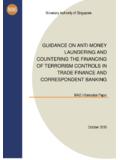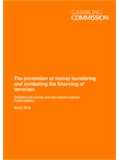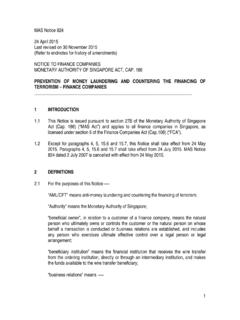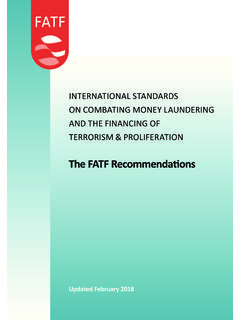Transcription of National Money Laundering and Terrorist …
1 Fatf GuidanceNational Money Laundering and Terrorist financing Risk AssessmentFebruary 2013 FINANCIAL ACTION TASK FORCE The Financial Action Task Force (FATF) is an independent inter-governmental body that develops and promotes policies to protect the global financial system against Money Laundering , Terrorist financing and the financing of proliferation of weapons of mass destruction. The FATF Recommendations are recognised as the global anti- Money Laundering (AML) and counter- Terrorist financing (CFT) standard. For more information about the FATF, please visit the website: 2013 FATF/OECD. All rights reserved. No reproduction or translation of this publication may be made without prior written permission. Applications for such permission, for all or part of this publication, should be made to the FATF Secretariat, 2 rue Andr Pascal 75775 Paris Cedex 16, France (fax: +33 1 44 30 61 37 or e-mail: Photocredits coverphoto: Thinkstock National Money Laundering and Terrorist financing Risk Assessment FATF Guidance 2 2013 Table of Contents ACRONYMS.)
2 3 1. INTRODUCTION & TERMINOLOGY .. 4 Purpose, scope and status of this guidance .. 4 Core FATF obligations and decisions regarding ML/TF risk 5 Key concepts and terms relevant to ML/TF risk assessment .. 6 Users of ML/TF risk assessments .. 8 2. GENERAL PRINCIPLES FOR National ML/TF RISK ASSESSMENTS .. 9 Clear agreement on purpose .. 9 Determining scope .. 10 Need for high-level commitment to the ML/TF risk assessment process .. 12 3. ORGANISATION AND INFORMATION .. 13 Planning and organisation of the ML/TF risk assessment .. 13 Sources of information .. 13 Other planning considerations .. 18 4. STAGES OF ML/TF RISK ASSESSMENT .. 21 First stage: identification .. 22 Second stage: analysis .. 24 Third stage: evaluation .. 27 5. OUTCOME OF RISK ASSESSMENTS .. 29 ANNEX I. ML/TF RISK FACTORS RELATING TO THREAT .. 31 ANNEX II. ML/TFRISK FACTORS RELATED TO VULNERABILITIES .. 39 ANNEX III. EXAMPLES OF National -LEVEL ASSESSMENTS .. 50 Australia.
3 50 The 54 Switzerland: Example of a risk assessment used as the basis for applying low-risk exemptions .. 55 United 56 ANNEX IV. SPECIFIC RISK ASSESSMENT METHODOLOGIES .. 57 BIBLIOGRAPHY .. 58 National Money Laundering and Terrorist financing Risk Assessment FATF Guidance 2013 3 ACRONYMS AML/CFT Anti- Money Laundering / countering the financing of Terrorism DNFBPs Designated Non-Financial Businesses and Professions FATF Financial Action Task Force FIU Financial Intelligence Units INR. X Interpretive Note to Recommendation X ML Money Laundering NPO Non-Profit Organisation RBA Risk-Based Approach SRB Self-Regulating Body STR Suspicious Transaction Report TF Terrorist financing National Money Laundering and Terrorist financing Risk Assessment FATF Guidance 4 2013 1. INTRODUCTION & TERMINOLOGY Purpose, scope and status of this guidance 1. Identifying, assessing, and understanding ML/TF risks is an essential part of the implementation and development of a National anti- Money Laundering / countering the financing of terrorism (AML/CFT) regime, which includes laws, regulations, enforcement and other measures to mitigate ML/TF risks.
4 It assists in the prioritisation and efficient allocation of resources by authorities. The results of a National risk assessment, whatever its scope, can also provide useful information to financial institutions and designated non-financial businesses and professions (DNFBPs) to support the conduct of their own risk assessments. Once ML/TF risks are properly understood, country authorities may apply AML/CFT measures in a way that ensures they are commensurate with those risks ,. the risk-based approach (RBA) which is central to the FATF standards as is set out in Recommendation 1, its interpretive note (INR 1), as well as in other Recommendations ( , Recommendations 10, 26 and 28). 2. This document is intended to provide guidance on the conduct of risk assessment at the country or National level, and it relates especially to key requirements set out in Recommendation 1 and paragraphs 3-6 of INR 1.
5 In particular, it outlines general principles that may serve as a useful framework in assessing ML/TF risks at the National level. The guidance contained in this document takes into consideration previous FATF work1, which is still valid reference material. The general principles contained in this paper are also relevant when conducting risk assessments of a more focussed scope, such as in assessments of a particular financial or DNFBP sector (for example, the securities sector) or of thematic issues (for example, the proceeds of corruption related ML). All of these types of assessments (comprehensive, sectoral or thematic) carried out at the National level may also form the basis for determining whether to apply enhanced or specific measures, simplified measures, or exemptions from AML/CFT requirements. Furthermore, while FATF Recommendation 1 does not create specific risk assessment obligations regarding the financing of proliferation of weapons of mass destruction, the general principles laid out in this guidance could also be used in conducting a risk assessment for this area.
6 3. The guidance in thi s document is not intended to explain how supervisors should assess risks in the context of risk-based supervision, although risk-based supervision will likely be informed by a National -level risk assessment. Also, this guidance does not provide further explanation of RBA obligations and decisions for financial institutions and DNFBPs. The FATF has issued separate 1 See bibliography for a list of relevant FATF work, National -level assessments available online and other relevant material. Annex III contains summaries of selected country-level assessment processes. National Money Laundering and Terrorist financing Risk Assessment FATF Guidance 2013 5 guidance on implementing the RBA for specific sectors and professions2, and that material will be reviewed and, as necessary, modified in light of the revised FATF Recommendations. This guidance document is not a standard and is therefore not intended to designate specific actions necessary to meet obligations under Recommendation 1 and INR 1 or any other Recommendations dealing with the RBA.
7 Criteria for technical compliance and for assessing effectiveness relevant to this and all other FATF Recommendations may be found in the FATF assessment methodology. The practices described in this guidance are intended to serve as examples that may facilitate implementation of these obligations in a manner compatible with the FATF standards. 4. This guidance is structured as follows: This section (1) lays out the purpose, scope and status of this guidance, along with an outline of the core FATF obligations relevant to ML/TF risk assessments at any level. Section 2 lays out general principles that should be taken into account when conducting ML/TF risk assessments at the country or National level. Section 3 discusses how to organise a National -level ML/TF risk assessment, its frequency, and the data and information that could be used while undertaking such an assessment. Section 4 presents a high-level view of the three main stages involved in the ML/TF risk assessment process (identification, analysis and evaluation).
8 Section 5 considers the outcome and dissemination of the risk assessment product. Annexes to this document contain additional information relating to ML/TF risk assessment including summaries of selected National -level assessments. Core FATF obligations and decisions regarding ML/TF risk assessments 5. It is important that the users of this guidance have an understanding of the obligations contained in Recommendation 1 and its interpretive note. This section provides a general outline of these obligations. For more details, reference should be made to the texts of Recommendation 1 and its interpretive note, as well as the FATF assessment 6. Recommendation 1: The text of Recommendation 1 lays out a number of basic principles with regard to risk assessment. First, it calls on countries to identify, assess and understand the ML/TF risks they face, and states that countries should also designate an authority or mechanism to co-ordinate actions to assess risks.
9 The goal of the standard is to ensure that countries can 2 Nine sectoral RBA guidance papers are available from the FATF website: This guidance will be revised following adoption of the revised FATF Recommendations in February 2012. 3 See FATF website ( ) for these texts. National Money Laundering and Terrorist financing Risk Assessment FATF Guidance 6 2013 mitigate their ML/TF risks effectively, and the risk assessment is clearly intended to serve as the basis for application of the risk-based approach, , to ensure that measures .. are commensurate with the risks identified. The text of the Recommendation adds that the [risk-based] approach (and therefore the risk assessment process on which it is based) should also be an essential foundation in allocating AML/CFT resources efficiently. Furthermore, the Recommendation indicates that risk assessments carried out by countries should be used for determining higher and lower risks that may then be addressed by applying enhanced measures or allowing simplified measures respectively.
10 The Recommendation concludes by requiring that financial institutions and DNFBPs should also be able to identify, assess and take effective action to mitigate ML/TF risks. 7. Interpretive Note to Recommendation 1: INR 1 provides more details on the requirement for countries to assess their ML/TF risks and on the purposes for which such assessments may be used4. In particular, it emphasises that the objective of the risk-based approach is to ensure AML/CFT measures are commensurate with the risks identified , as well as to enable decision making on effective resource allocation. In elaborating on the specific obligations and decisions for countries, INR 1 states that countries should take steps to identify and assess their ML/TF risks on an ongoing basis. The objectives of the process at the country level are: (1) to provide input for potential improvements to the AML/CFT regime, including through the formulation or calibration of National AML/CFT policies, (2) to help in prioritising and allocating AML/CFT resources by competent authorities, including through feeding into any risk assessments conducted by such competent authorities ( , supervisors) and (3) to feed into the AML/CFT risk assessments carried out by financial institutions and DNFBPs.















